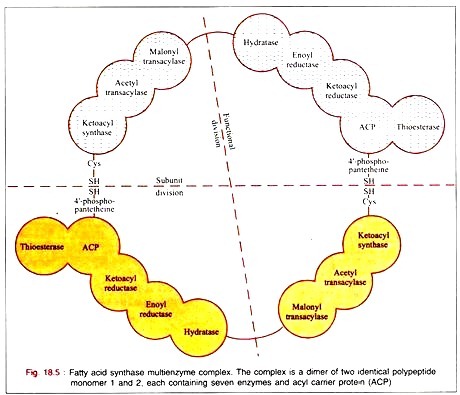ADVERTISEMENTS:
The following points highlight the top three systems for fatty acid synthesis. The systems are: 1. Mitochondrial System 2. Microsomal System for Chain Elongation 3. Extra Mitochondrial System for De NOVO Synthesis.
Fatty Acid Synthesis System # 1. Mitochondrial System:
a. Mitochondria catalyze the incorporation of acetyl-CoA into long chain fatty acids under anaerobic conditions.
b. The enzymes are mostly the same as those involved in P-oxidation excepting α, β-un- saturated acyl-CoA reductase which converts α, β-unsaturated acyl-CoA to a saturated compound, requiring NADPH + H+
ADVERTISEMENTS:
c. Pyridoxal phosphate (B6 – PO4) as a coenzyme is required for the enzyme condensing acetyl-CoA with acyl-CoA; thus, thiolase is not used in this synthetic pathway.
d. Since this system takes place under anaerobic condition the physiologic significance of this pathway is uncertain.
Fatty Acid Synthesis System # 2. Microsomal System for Chain Elongation:
a. This is the main pathway for the elongation of existing fatty acid molecules.
ADVERTISEMENTS:
b. Acyl-CoA compounds are converted to higher fatty acids by means of malonyl-CoA along with NADPH + H+. The acyl groups include the saturated series from C10 – C16 as well as some unsaturated C18 fatty acids.
c. Fasting prevents chain elongation.
Fatty Acid Synthesis System # 3. Extra Mitochondrial System for De NOVO Synthesis:
De novo synthesis of palmitic acid from acetyl-CoA is carried out in the cytoplasm by fatty acid synthase (multi enzyme complex). This mainly takes place in liver, kidney, lactating mammary gland, brain etc.

